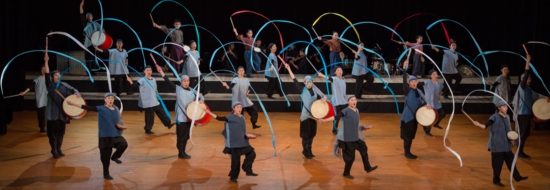 What is Eisa?
What is Eisa?
Eisa is a traditional drum dancing in Okinawa, the southern part of Japan. It is performed to respect ancestors and hold a memorable service for them. Nowadays, while people think a great deal of tradition, they produce new pieces and adopt new songs, and open up new aspects in the traditional culture.
Okinawa is the only place in Japan where they had the ground battle in 1945 at the last stage of World War II and one fourth of the inhabitants were dead.
We, the Group Karakoro, consider it important to continue to perform Eisa in order to keep the Okinawan traditional performing arts and maintain peace.
In addition to classical Eisa, we have performed some programs on discrimination and war, such as “Takeda-no-komoriuta (A Lullaby from the Takeda Region)” and “Satokibi-batake (Sugarcane Fields).”
Also, we produced some Eisa pieces, based on Kenji Miyazawa’s novel “Night of the Milky Way Train,” “Kazeno-Matazaburo” and “Snow Crossing.” These works imply the archetype of Japanese mentality: to be humble, not to look down upon the weak and the little, to look at things with natural eyes and to listen to nameless grass and flowers with natural ears.

 From Okinawa to Canada
From Okinawa to Canada
It has been 18 years since we started to work on Eisa. We attended the 10,000 Eisa Dancers Parade of Okinawa, had a performance and exchange meeting at a national Hansen’s disease sanatoria “Airakuen,” and won second place in “All Japan Eisa Contest” held in Okinawa City in 2010. Also, we have performed Eisa in Canada every summer for 10 years.
Our Eisa performance in Canada has become our annual event in summer. So far we have performed in various places in Canada, such as at Ryerson University, for the music festival in Niagara-on-the-Lake, at Japanese Canadian Culture Centre in Toronto, at Art Gallery in Winnipeg, and for Powell Festival in Vancouver.
Following what we did last year, we will perform for the Folklorama Festival. We’ll give our Eisa performance three times: at 6:45 p.m., 8:15 p.m. and 9:45 p.m. on Friday, August 16th. The Folklorama has continued for about 50 years and people of 41 countries get together. The Japanese pavilion is sponsored by Japanese Cultural Association of Manitoba (JCAM). JCAM is an non-profit, charitable organization that serves as the representative organization for Japanese Canadians in Manitoba. JCAM organizes cultural and educational activities for the community through a volunteer board and the organization’s membership. JCAM undertakes projects that include all segments of the Japanese Canadian community, as well as reaching out to other Canadians.
And, invited by Canadian Museum for Human Rights, we will perform Eisa at 1:00 p.m. on Sunday, August 18th.
Canadian Museum for Human Rights opened in Winnipeg in 2014. Originally, Winnipeg was rich in history of indigenous people, and the women’s liberation movement and the labor movement were active there. Those are the background factors.
The exhibition is rich in content and covers various topics, such as the history of First Nations in Canada, the history of Japanese Canadians, the murder and disappearance problem of First Nations’ women, Apartheid in South Africa and the military comfort women’s problem in Japan.
After our Eisa performance ends, as an encore we will perform “Nkosi Sikelel’ iAfrika,” which has spread as the song of freedom and now is sung by the national anthem of South Africa in hope that this hall would echo with our voices.
Yoko Matsui

Photo by Nobuyo Nishimura
Kazuma Torii


 HOME
HOME